"The gold is the silk, the hand is hand-knotted, and the jade is embellished with jade. It is a must." These words properly explain the craftsmanship of the filigree inlay, reflecting the people's pursuit of craftsmanship and the pursuit of richness and luxury. . As one of the representatives of traditional Chinese gold and silver making techniques, the filigree inlay process has a long history and a long history. It uses the ductility of precious metals to make materials such as gold or silver into filaments. After eight major techniques, such as smashing, stacking, weaving, weaving, weaving, and welding, it is made into fine jewelry or utensils. Ethnic style.
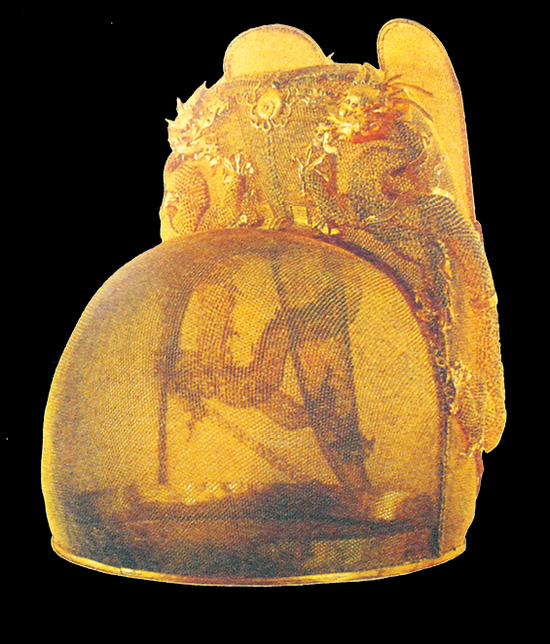
"Golden Silk Dragon Wings Good Crown" Ming Ding Ling Museum
As early as the Spring and Autumn Period and the Warring States Period, the refinement, manufacture and use of silver had a great development. In the Qin and Han Dynasties, the court had a specialized agency for gold and silver smelting, called the "worker." In the two Han dynasties, the gold and silver fine gold crafts have made new breakthroughs - there are patterns of filigree, Xiangsi, Jinzhu, etc. The techniques of silk, weaving, weaving, etc. and the pattern of filigree patterns are amazing. In the production process, a complete set of techniques such as boring, filling, braiding, boring and welding has been formed, which enriches the expressive power of the filament process and makes the objects more perfect in terms of styling, decorative patterns and decorative techniques. Since then, the dynasties of the Tang, Tang, Song, Yuan, Ming and Qing dynasties have also created many distinctive techniques that can represent the level of the dynasty on the basis of the use of traditional techniques, and have been continuously improved and improved in practice. And development. In the Ming and Qing Dynasties, the filament weaving process and the filigree filling process reached a new realm of pure fire green. In the Ming and Qing dynasties, the technique of silk filigree can be described as a collection of dynasties and exquisite art styles.
"Fiber" and "transparent" Ming Dynasty silk process
The masterpiece of the honeysuckle silk craft of the Ming Dynasty was the "Golden Silk Dragon Wings Good Crown" collected by the Dingling Museum after being unearthed from Dingling, Beijing. This crown is the favorite of Wanli Emperor Zhu Xi's life. The crown is 24 cm high and 17.5 cm in diameter. It consists of three parts: “front houseâ€, “back mountain†and “wingâ€. The Golden Crown uses 518 golden filaments (each with a diameter of only 0.2 cm) to weave a uniform, fine "lantern empty" flower that is as thin as a yarn. The top of the crown is decorated with a set of three-dimensional hollow two-dragon play beads. The dragon's body is also meticulously twisted with filigree, and then the base is welded and fired. The crown weighs only 826 grams, which is called Chinese silk craft. Model work.
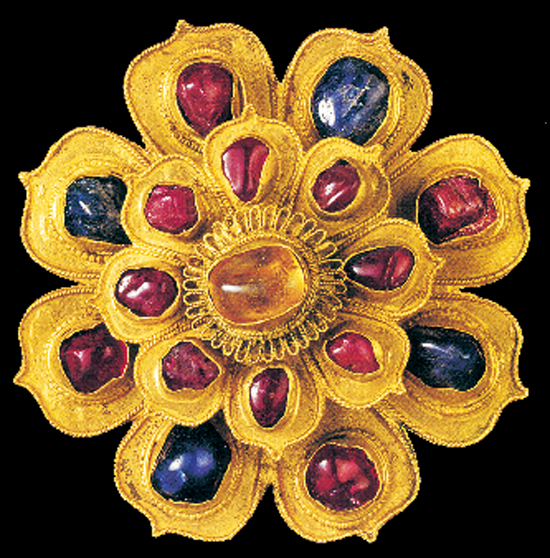
"Inlaid Gems of Sunflower Shaped Gold" Ming Museum of the Ming Dynasty
Jewelry jewellery is popular in the Ming Dynasty. The gems inlaid on it include red sapphires, turquoise, agate, crystal, etc., among which red and sapphire are more. When the combination of luxurious jewels and exquisite filigree craftsmanship, they complement each other, both graceful and dazzling. The inlaid gemstone-shaped golden dragonfly unearthed from the Ming Tomb of the right gate of Beijing is one of the typical filigree inlays. It is 13.5 cm long and weighs 76.8 cm. It is made of sunflower. It is divided into three layers. The center of the flower is centered on the yellow tourmaline. The flower core is surrounded by the flower, and the stone bowl is welded around the stone bowl. Filaments to make it more solid. The outer ring of the flower heart has eight petals inlaid with ruby ​​petals. The petals are also surrounded by filaments. The outermost petals are also inlaid with red and blue colored gemstones to make the jewelry more colorful. The overlapping petals and decorative filaments make the whole product vivid and three-dimensional.
The characteristics and techniques of arts and crafts are closely related to the times. What kind of aesthetics, there will be any kind of craftsmanship. Thanks to the Ming Dynasty's "fibre" and "transparent" aesthetic tendency, the filigree process has been fully exerted, and the skillful and sophisticated craftsmanship has deepened people's favor for such products, and their pursuit of exquisite and translucent effects, the two complement each other. In the end, it will promote the art of Ming Dynasty silk crafts with distinctive features.
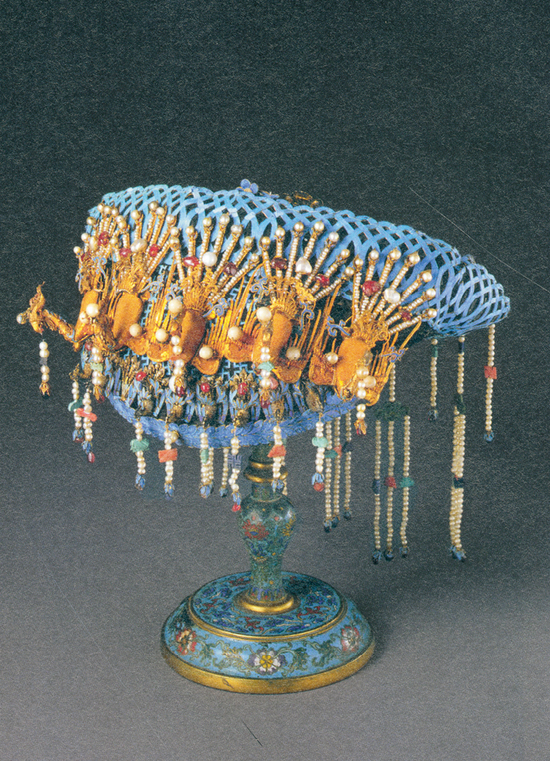
"Golden silk inlaid jewels and phoenixes" Qing Palace Museum
"fine" and "fine" Qing Dynasty gold and silver fine gold craft
The gold and silver fine gold crafts of the Qing Dynasty are similar to the silk crafts of the Ming Dynasty. The visually complex and complex, all faintly have the western Baroque art style. However, the products of the two dynasties also have their own differences: in general, the jewelry of the Ming Dynasty has not yet been removed from the simplicity, and the jewelry of the Qing Dynasty has become more and more gorgeous. In terms of craftsmanship, the exquisite craftsmanship of the Qing Dynasty jewellery is also inaccessible to the Ming Dynasty jewellery.
The processing characteristics of silk jewellery in the Qing Dynasty can be summarized by the words "fine" and "fine". Compared with the Ming Dynasty jewellery, the styling and ornamentation of the Qing Dynasty jewellery has changed a lot. It has no quaint meaning, and it is more inclined to pursue the unique richness and luxury of the palace gold and silver art. The style of jewellery in the Qing Dynasty tends to be realistic, and the ornamentation is characterized by its dense and beautiful, elegant style, or magnificent, with the exquisite craftsmanship of various colored stones, the products are more colorful and golden. The "fine" and "fine" of the filigree process of the Qing Dynasty made the products reach the realm of perfection in both the shape and the processing of the ornamentation.
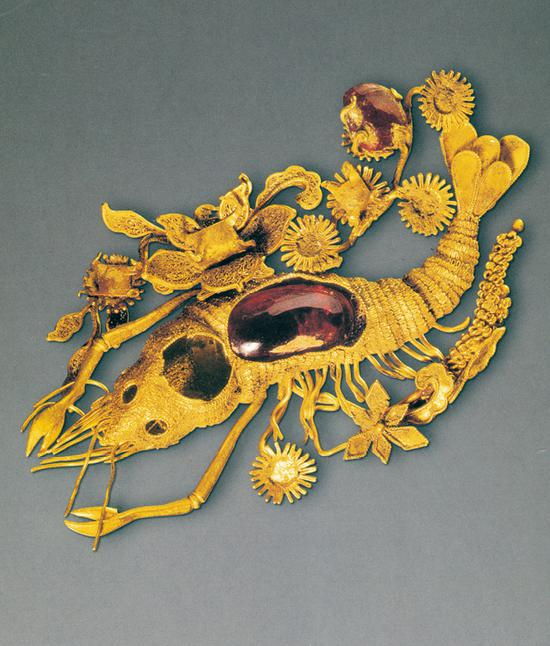
"Tired inlaid jewelry shrimp gold ornaments" Qing Capital Museum
There are many handed down works of gold and silver products in the Qing Dynasty, the most distinctive of which is royal products. From the point of view of use, royal products include crown jewelry, daily necessities, furnishings, palace seals, sacrificial utensils, religious supplies and so on. From the source point of view, there are two types of royal products, one is for the gold jade made by the royal family; the other is the tribute products of the local governors. The tributes are mostly produced in Beijing, Nanjing, Hangzhou, Guangzhou, etc. The history of making gold and silver products in these places is very long, the talents are relatively concentrated, and the traditional techniques are passed down from generation to generation.
The "Golden Silk inlaid Jewelry Phoenix", which is now collected by the Palace Museum, is a phoenix that was worn by the empress of the Qing Dynasty when wearing a robes. This phoenix phoenix is ​​narrow and wide, and the front is high and low. The cardboard is engraved with a continuous mesh pattern, and the surface is all green. The front part of the dragonfly is adorned with 5 golden silk phoenixes, and the phoenix is ​​lined with 9 silver-plated gold enamels, phoenix and mouth-shaped pearls. The tassels are adorned with pearls, corals, turquoise, lapis lazuli and red sapphires. There are 50 large pearls, hundreds of second-class and third-class pearls, and more than 200 gemstones. .
Unearthed in Shangzhuang Township, Haidian District, Beijing, it is now housed in the Capital Museum's "The Qing Dynasty's Infused Silk Shrimp-shaped Gold Ornaments", which also reflects the refined and luxurious characteristics of the Qing Dynasty jewelry. Taking the "shrimp" on it as an example, its molding process is more refined than the previous one, the shape is more realistic, and it has become more realistic. The gem setting process on it is more sophisticated, and the filiform at the incision is extremely delicate. The shrimp body adopts the silk thread process in the filigree process, which makes it more three-dimensional, full of sensation, and the vivid scenes such as lotus and duckweed, which are also made by the silk process, are like a common shrimp in Chinese painting. Lotus map.
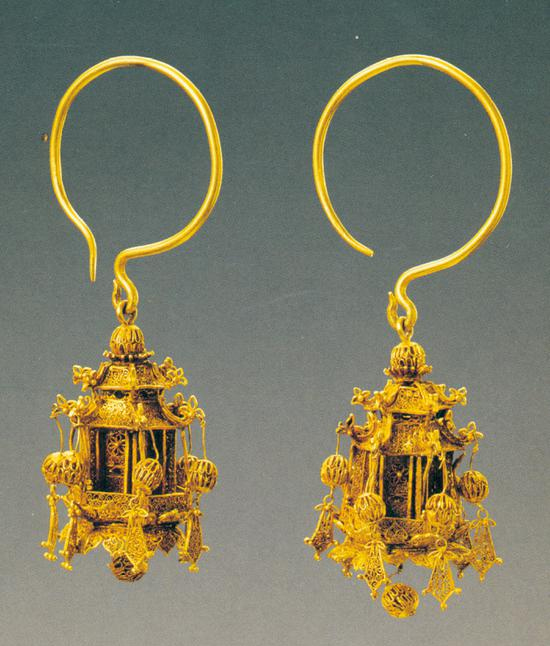
"Accumulate Palace Light-shaped Gold Earrings" Qing Capital Museum
The silk process of the Qing Dynasty not only strives to be realistic and vivid in the modeling of animals, but also fully demonstrates its ability to use gold wire in the shape of the attic and utensils. Compared with the previous dynasty, the Qing dynasty jewelry pursues the difficulty of craftsmanship and the visual beauty. For example, the "Golden Ears of the Qing Dynasty", which was unearthed from Shijingshan in Beijing, creates a rich sense of space and layering through a variety of filament crafts. Every detail is done in place. This product is not so much a piece of jewelry that people wear, but rather a piece of art that can be used for people to play with.
Through the appreciation of the above works, you can get an idea of ​​the characteristics of the Ming and Qing dynasty silk jewellery: First, compared with the previous generations, the filament process began to dominate in many jewellery production processes; second, the combination of the filament process and the mosaic process The color technology of jewelry is gorgeous and rich; thirdly, in the processing of ornamentation, the filament process can express its three-dimensional and vivid characteristics compared with other processes; fourthly, the filament process conforms to the aesthetic tendency of the Ming and Qing Dynasties, and will be rich and luxurious. The jewelry is pushed to the extreme in craftsmanship.
100% cotton dress, soft and comfortable
Loose version, enlarged dimension design, free and comfortable
SHAOXING LIDONG TRADING CO.,LTD , https://www.lidong-garment.com